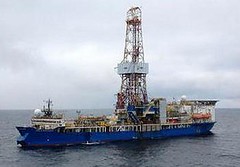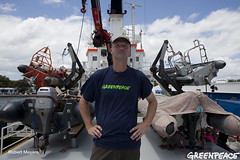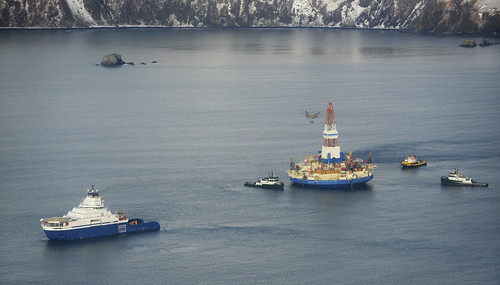1月6日晚間,搶救隊成功讓元旦擱淺在阿拉斯加灣區的殼牌鑽油船庫魯克號(Kulluk)脫離礁石。
在人員評估船隻情況時,庫魯克號漂浮在海面。該船本身並沒有推進系統,其所依賴的殼牌所有的拖曳船Aiviq號上週末因風暴導致發電機故障。目前一位美國海岸防衛隊巡官登上Aiviq號。海岸防衛隊的Cutter Alex Haley號及兩艘漏油應變船隻還有三艘拖曳船都在待命中。
意外指揮官Martin Padilla表示:「在開始第一步後,我們將保持謹慎的繼續協助庫魯克號事件。在我們有信心我們可以安全的運送這艘船前,我們將不會有進一步行動。」
官員們決定天候平穩足以進行庫魯克號拖曳作業。庫魯克號目前正被從擱淺一週的錫特卡利達克島(Sitkalidak Island)拖往30哩遠、科迪亞克島東側的基魯達灣(Kiliuda Bay)。
阿拉斯加環保部現場協調員Steve Russell表示,基魯達灣是附近七個避難所之一;基魯達灣偏遠而原始,且只有一個釣魚小屋,僅能藉由船隻或是水上飛機抵達,但它的能提供的保護性比錫特卡利達克島好。
海岸防衛隊運用支援船隻上的紅外線設備,確認庫魯克號穩定,且裝載的14.3萬加侖柴油和約1.2萬加侖的潤滑油及液壓油並未漏出。
1月6日搶救小組成功的將主纜繩安置於排水量2.8萬噸的庫魯克號上。
荷蘭皇家殼牌行動經理及意外指揮Sean Churchfield1月5日表示,該船「健全且適合拖曳」。但在1月4日的記者會上,登船的搶救小組發現緊急發電機與上層甲板皆有損毀。
庫魯克號在結束過去20年第一次於美國北極圈海域油井鑽探作業後,由波福海往南拖曳時被數個風暴波及。
在庫魯克號數條拖曳纜繩斷裂、接近颶風等級的天候下,兩艘拖曳船船員於切斷纜繩自保前,仍在超過33呎的浪高與時速60哩的狂風中,拖著巨大的庫魯克號航行超過10哩試圖靠近岸邊。
庫魯克號擱淺於科迪亞克島外的小島錫特卡利達克島。錫特卡利達克島為環境敏感區,棲息著瀕危的鯨魚與海鳥。由於對流入大洋灣鮭魚流的關注,統一指揮部預防性的安置攔油索。
史密特援救公司搶救人員登上庫魯克號並將船隻拖往魯達灣途中持續停留船上。另外一組10人搶救隊及殼牌公司代表也將登船並於拖曳期間留在船上。
三艘總部位於西雅圖的遠洋拖曳船也配備拖曳裝備支援這次拖曳行動,同時將於庫魯克號及拖曳船上安置拖曳警報裝置。
整個拖曳行動由海岸防衛隊快艇亞歷斯海勒號(Alex Haley)護送。在運送過程及安置於基魯達灣後,都將保持500碼的安全距離。
應變行動調度700餘人
聯邦現場協調員,海岸防衛隊Paul Mehler III上尉表示:「參與人員的安全仍是我們行動的第一優先考量。在不危及安全的情況下,我們試圖在惡劣的天候及自然環境中作業。」
「目前很難訂定明確的時間表,但我們承諾以安全為因應原則。在操作過程中我們會隨時因應新的問題或疑慮調整我們的計畫。」
一旦抵達基魯達灣,已有30年船齡的庫魯克號將接受殼牌、諾保鑽油公司(Noble Drilling)、阿拉斯加環保部的調查與評估。
北極出事牌鑽油船不只一艘
 另一艘由殼牌用於北極鑽油的諾保鑽油公司船隻正由海岸防衛隊稽查員調查中,並不排除提出刑事控訴。
另一艘由殼牌用於北極鑽油的諾保鑽油公司船隻正由海岸防衛隊稽查員調查中,並不排除提出刑事控訴。
514呎的諾保發現者號(Noble Discoverer)由殼牌於楚科奇海域的離岸鑽油井。但這艘利比亞籍的船隻麻煩事一直不斷。
2012年5月21日,在諾保發現者號即將開往北極海前幾日,一項針對該船的檢查共發現包括艙底水管理系統、通風系統、電力系統及發動機等23項缺失。在這些項目改善後該船隨即向北開航。
同年7月於阿拉斯加荷蘭港,該船拖錨飄至岸邊。
9月24日,在調查停放在安克拉治的諾保發現者號排油後,針對該船提出「污染源」執法的警告。
11月,根據烏納拉斯卡消防局的紀錄,該船在阿拉斯加的國際港-荷蘭港發生火災。殼牌聲稱只是一場小火災,但在200碼外都可感受到爆炸的威力。
11月30日Mehler上尉針對諾保發現者號提出港口國監督拘留(Port State Control Detention),扣押該船於港內直到違反安全項目都被解決為止。12月19日被釋放後,諾保發現者號仍停留在阿拉斯加的席沃(Seward)進行維修。
北極鑽油風險大 各界籲殼牌止步
庫魯克號2012年因為成為污染源而收到三次執法的警告。另2012年5月由海岸防衛隊進行的調查發現電力及維護系統有19項缺失。
殼牌2012年並未鑽探到含油區,該公司希望2013年能繼續回到北極進行原油探鑽作業。但在檢視所有問題後,環保人士和國會議員們呼籲聯邦政府取消殼牌的鑽探許可證。
由45位民主黨眾議員發起的「眾議院永續能源與環境聯盟(House Sustainable Energy and Environment Coalition,SEEC)」1月4日發表聲明:「殼牌公司庫魯克號近期擱淺事件揭露了北極鑽油的風險。這是漣漪般層出不窮的事件(包括船齡47歲的諾保發現者號差點於荷蘭港擱淺、北極挑戰者號穹頂爆裂)中最新的一起。」
該聯盟表示這一系列的意外事件將受到徹底調查。
環保人士表示北極的條件太嚴苛,許可鑽油的賭住太大。
自然資源保護委員會及荒野協會1月4日呼籲歐巴馬政府,立刻凍結所有目前及未來的北極海離岸石油勘探許可。
自然資源保護委員會國家公園及阿拉斯加專案執行長Chuck Clusen表示,殼牌一長串的意外及失誤以本週發生的庫魯克號事件為甚,而這些事件清楚的顯示在美國北極圈內開採石油是個很糟的主意。
Clusen指出,「因為承受的風險太大,在地球上最脆弱的環境之一(北極)鑽油註定是錯的。由庫魯克號擱淺事件我們瞭解到在太平洋沿岸西雅圖以北整個區域探勘的風險。」
 美國綠色和平副主任Dan Howells表示,「庫魯克號擱淺事件中,船身損害多嚴重,對殼牌公司商譽的危害就有多嚴重。目前很難想像殼牌要如何救援這艘船、修復它並在2013年鑽油季節捲土重來。」
美國綠色和平副主任Dan Howells表示,「庫魯克號擱淺事件中,船身損害多嚴重,對殼牌公司商譽的危害就有多嚴重。目前很難想像殼牌要如何救援這艘船、修復它並在2013年鑽油季節捲土重來。」
「殼牌45億美元北極鑽油的豪賭看來是個嚴重的錯誤,並可提供其他打算在此區鑽油的公司作為借鏡。美國政府應該停止授權開採北極石油,並自無能的殼牌公司手中保護美國海岸線。石油公司無法在極區安全的作業,在純淨的北極圈中,任何工業意外導致的風險與衝擊都將難以承受。」
內政部和其他機關現正檢討未來的北極海鑽探許可申請。緊接著殼牌,康菲石油公司已申請2014年開始在楚科奇海鑽探的許可證。
Late Sunday night crews were successful in refloating the Shell drilling rig Kulluk that grounded in the Gulf of Alaska on a stormy New Year’s Eve.
The Kulluk was first floated offshore while personnel assessed the condition of the vessel. The rig, which does not have its own propulsion system, is attached to the Aiviq, a Shell-owned, anchor-handling vessel with ship towing capabilities that suffered an engine breakdown in the storm last weekend. A U.S. Coast Guard marine inspector is aboard the Aiviq. Three additional tugs are on standby along with the Coast Guard Cutter Alex Haley and two oil spill response vessels.
“Following this initial step forward, we will continue to remain cautious while we assess the Kulluk’s condition,” said Martin Padilla, Incident Commander. “We will not move forward to the next phase until we are confident that we can safely transport the vessel.”
Officials decided the drill rig was safe to tow and the weather calm enough to proceed. It is currently being towed from Sitkalidak Island, where it spent a week aground, to Kiliuda Bay on the east side of Kodiak Island, about 30 miles to the north.
Steve Russell, Alaska Department of Environmental Conservation on-scene coordinator, said Kiliuda Bay was one of seven nearby areas of refuge. The remote pristine bay has one fishing lodge accessible only by boat or floatplane, but it is more sheltered than Sitkalidak Island.
Using infra-red equipment on board a support vessel, Unified Command officials confirm that the Kulluk is stable and is not leaking any of the 143,000 gallons of diesel and about 12,000 gallons of lubricating oil and hydraulic fluid aboard.
Salvage teams successfully attached the main tow line to the 28,000-ton conical drilling rig Sunday afternoon.
The vessel is “sound and fit to tow,” said Sean Churchfield, operations manager and incident commander for Royal Dutch Shell, at a media briefing Saturday. But at a news conference Thursday, Churchfield that salvage crews who boarded the vessel found damage to emergency and service generators, and to the Kulluk’s upper deck.
The rig, was being towed south from the Beaufort Sea after taking part in the first offshore oil exploration in the U.S. Arctic in two decades, when it ran into a severe storm.
In near-hurricane conditions, after the Kulluk had snapped numerous tow lines, the massive rig dragged the two vessels trying to tow it more than 10 miles toward shore in waves up to 33 feet and winds up to 60 miles an hour before crews cut it loose to save their own lives.
The Kulluk grounded on Sitkalidak Island, a small island off the much larger Kodiak Island. It was in an environmentally sensitive area populated by endangered whales and seabirds. As a precaution, Unified Command deployed oil containment boom with special attention to salmon streams entering Ocean Bay.
The Salvage Master from the salvage company Smits is aboard the Kulluk and will remain during transit to Kiliuda Bay. A 10-member salvage crew and one Shell representative also are on board the Kulluk and will remain on the drilling unit throughout the tow.
Three Seattle-based ocean-going tugs, all with towing capabilities, are supporting the transit – Ocean Wave, Corbin Foss and Lauren Foss. The tug Alert will also be connected to the Kulluk and assist in the tow.
The Coast Guard Cutter Alex Haley is escorting the tow to Kiliuda Bay. A 500-yard radius safety zone around the Kulluk will follow the tow and remain in place once it is anchored in Kiliuda Bay.
More than 700 personnel are working on the response and recovery effort
“Safety of the response personnel remains our No. 1 priority,” said Federal On-Scene Coordinator USCG Captain Paul Mehler III. “The very nature of the recovery operations and the difficult weather conditions must be managed without compromising safety.
“Our timeline is still difficult to nail down, but we are committed to seeing this response through to a safe conclusion. Understand that as recovery operations develop, it may be necessary to alter our plans to address new issues or concerns,” said Mehler.
Once in Kiliuda Bay, the 30-year-old Kulluk will be subjected to extensive inspection and evaluation by Shell, Noble Drilling, which operates the rig, and the Alaska Department of Environmental Conservation.
Now, another Noble Drilling ship used by Shell for its inaugural Arctic drilling effort is being investigated by Coast Guard inspectors who have not ruled out criminal charges.
Shell used the 514-foot Noble Discoverer for drilling at one well at the Burger-A Prospect 70 miles offshore in the Chukchi Sea.
But the Liberian-flagged vessel has been plagued with problems.
On May 21, in Seattle, days before the ship sailed north to the Arctic Ocean, an inspection of the Discoverer found 23 deficiencies, including problems with bilge water management system, ventilation, electric system, and ship’s engine.
Once these were resolved to the inspectors satisfaction, the Discoverer proceeded north.
In July while in Dutch Harbor, the ship lost its mooring and drifted close to shore.
An “enforcement warning” for being a “pollution source” was issued to the Noble Discoverer in Anchorage, on September 24, following an investigation into an oil discharge.
On November 16, it caught fire in Dutch Harbor, an international port in Alaska’s Aleutian Islands, according to the Unalaska Fire Department. Shell called it a small fire, but the fiery blast was felt 200 yards away.
On November 30, Capt. Mehler issued a Port State Control Detention for the Noble Discoverer, keeping it in port until safety violations were repaired. By December 19, the ship was released from Port Detention but remains in Seward, Alaska for repairs.
The Kulluk has had three enforcement warnings in 2012 for being a source of pollution, and a Coast Guard inspection last May that found 19 deficiencies in electrical and maintenance systems.
Shell did not reach oil-bearing zones this year, and the company hopes to return next year to drill deeper and find oil.
But environmentalists and Members of Congress are calling for the federal government to cancel Shell’s drilling permits in view of all these problems.
House Sustainable Energy and Environment Coalition, made up of 45 House Democrats, issued a statement Thursday saying, “The recent grounding of Shell’s Kulluk oil rig amplifies the risks of drilling in the Arctic. This is the latest in a series of alarming blunders, including the near-grounding of another of Shell’s Arctic drilling rigs, the 47-year-old Noble Discoverer, in Dutch Harbor and the failure of its blowout containment dome, the Arctic Challenger, in lake-like conditions.”
The coalition said these “serious incidents” warrant thorough investigation.
Environmentalists have said for years that Arctic conditions are too harsh and the stakes too high to allow drilling.
The Natural Resources Defense Council and The Wilderness Society Thursday called on the Obama administration to put an immediate hold on all current and future approvals for offshore oil exploration in the Arctic Ocean.
Shell Oil’s long string of accidents and mistakes – culminating with Shell losing control of its Kulluk drilling ship this week – makes it crystal clear what a bad idea it is to drill offshore America’s Arctic, said Chuck Clusen, NRDC’s director of national parks and Alaska projects.
“The risks are too big to get this wrong – especially in one of the most fragile places on the planet,” Clusen said. “And, as we’ve learned this week from the grounding of the Kulluk, the risks of exploration extend all up and down the fragile Pacific coastline from Seattle to the top of the world.”
Greenpeace USA Deputy Campaigns Director Dan Howells said, “The rocks grinding against the Kulluk’s hull are damaging Shell’s corporate reputation just as badly as the rig itself. It’s hard to see how this company can salvage this rig, repair it and regain the public’s trust in time for the 2013 drilling season.”
“Shell’s US$4.5 billion Arctic gamble is looking like a serious mistake, and should act as a warning to other companies looking to drill in this incredibly hostile environment,” said Howells.
“The US administration should stop licensing Arctic drilling and start protecting America’s coastline from Shell’s incompetence,” he said. “Oil companies cannot operate safely in the pristine Arctic, where both the risks and the impacts of any industrial accident are too great to bear.”
The Department of the Interior and other agencies are currently reviewing permit applications for future Arctic Ocean drilling. Along with Shell, ConocoPhillips has applied for permits to begin drilling in the Chukchi Sea in 2014.
※ 全文及圖片詳見:ENS








